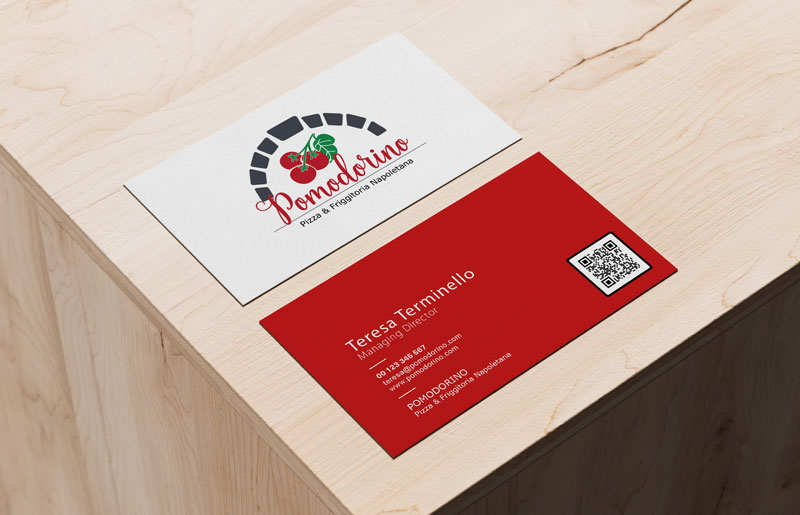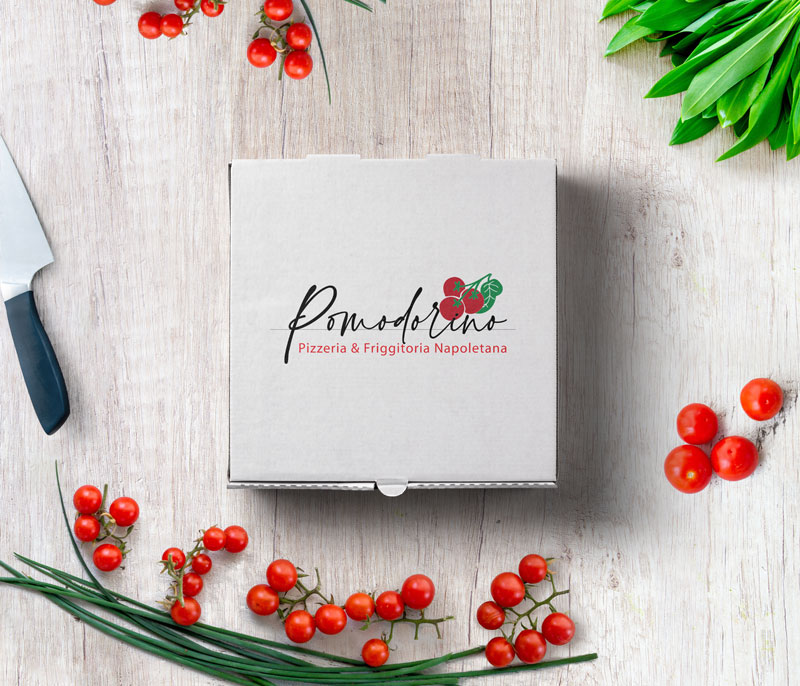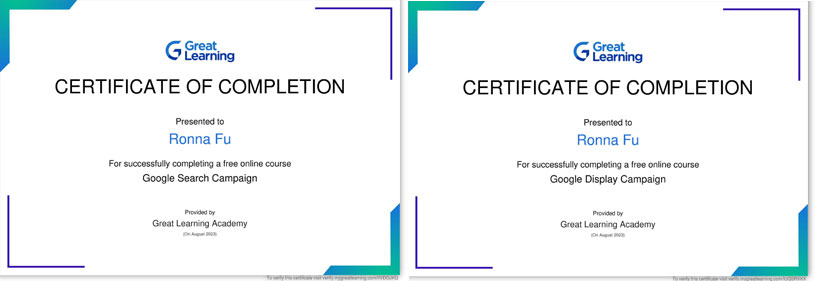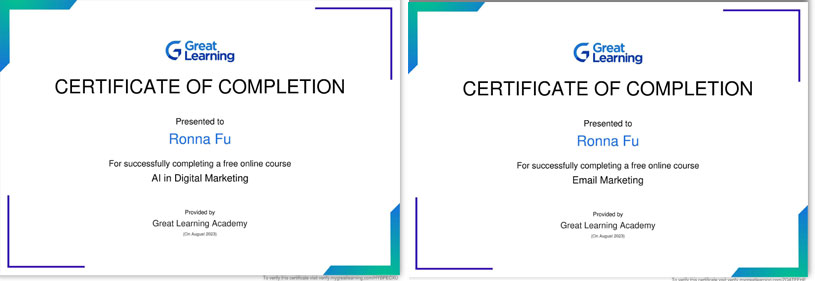

In Latin, univerbation of pomo (“apple”) + d’ (“of”) + oro (“gold”), literally “golden apple”. Perhaps because the first tomato cultivars to reach Europe and spread from Spain to Italy and North Africa were yellow. Pomodorino, which translates as ‘cherry tomoto’ in Italian, is the name chosen for the pizza restaurant in Greece.

Concept 1, Pomodorino Pizza and Friggitoria Napoletana Restuarant logo

Concept 1 Pizza box mockup

Concept 1 logo transfer to a T-shirt mockup.

Use of the Concept 1 logo in various promotional designs and layouts.

Concept 2: Logo on mug mockup. Two colours on dark background.

Concept 2 Promotional merchandise. Mockup of a t-shirt showing how the logo stands out against a dark background.

Concept 3. Cherry tomatoes and the door of the pizza oven were combined to produce the third concept.

Concept 4 was the final design selected. The carefree, relax, and informal vibe that the business owner wants to portray is reflected in the usage of free-style fonts and illustrations.

Concept 4 was the final selected logo for Pomodorino Pizza and Friggitoria Napoletana Restuarant

Digital Ad Expert in Digital Marketing is a three months part-time course by Aleph. Digital Marketing is a step-by-step approach to marketing strategy, giving the student the tools to create a precise and successful online marketing campaign. Live classes were held twice a week, and each class lasted 2 hours.
I gained knowledge about every aspect of digital marketing, from its fundamentals to its formal terms, applications, and techniques. The course includes all current data on digital realities to aid in the development of an awareness of the significance of social media in the modern world. I gained knowledge about how this material is consumed and how it affects society, people, brands, and businesses.
The programme covered how to implement a marketing plan with a specific goal. A major goal is to comprehend the range of available marketing objectives. In order to achieve this, we learned to thoroughly understand the company we want to promote in order to decide on the right audience to communicate with and the most effective method.
A Google Search campaign is a particular type of online marketing campaign that runs through Google Ads, formerly known as Google AdWords, Google’s platform for online marketing. When consumers conduct a Google search for a certain keyword, text advertising are intended to be displayed to them.
Google Search campaigns are an effective approach to reach people who are looking for items or services similar to yours right now. They enable you to connect with a very targeted audience and track the success of your campaign using statistics like clicks, impressions, click-through rate (CTR), and conversion rate.

Choosing keywords that are pertinent to your enterprise, goods, or services is the first step in conducting keyword research. These are the terms and phrases that customers might type into the Google search box to find products and services similar to yours.
You produce text-based advertisements that are pertinent to the selected keywords. Every advertisement normally has a headline, a few lines of information, and a display URL.
The maximum bid that you set for each term is what you’re willing to spend when someone clicks on your ad. The position of your ad on the search results page is determined by this bid together with other elements like ad relevancy and quality score.
Google’s Ad Rank algorithm determines the position of the adverts on the search results page. Your bid, ad quality, anticipated click-through rate, ad relevancy, landing page experience, and other variables are used to determine your ad rank.
Google’s algorithm chooses which advertisements to display when consumers search for a keyword you’re targeting depending on the Ad Rank. Depending on the competition and your bid, your ad may appear at the top, bottom, or side of the search results page.
The cost-per-click (CPC) bidding mechanism determines how much you are charged if a user clicks on your advertisement. The most you’re willing to spend on the campaign is your budget.
A user is taken to a landing page on your website when they click on your advertisement. The landing page should give a positive visitor experience and be pertinent to the advertisement.
You keep an eye on the campaign’s effectiveness using the reporting tools provided by Google Ads. To increase the effectiveness of the campaign, you can change bids, add new keywords, halt underperforming advertisements, and execute other optimisations.
This summer, I enrolled in as many courses as I could to increase my understanding of every facet of marketing. My most recent courses were Email Marketing and AI Marketing.

When done right, Email Marketing can be a powerful instrument for establishing and fostering customer relationships, boosting revenue, and preserving brand engagement. To get the best outcomes, it is critical to regularly modify your plans based on subscriber behaviour and market trends.
Here are some key aspects and best practices of Email Marketing:
The first step in creating a subscriber list is to compile a list of people who have granted you consent to send them emails. Website sign-up forms, social media, events, and other lead generating techniques can all be used to do this.
Individual subscribers are not all created equal. Segment your email list according to several factors, such as demographics, interests, behaviours, or past purchases. This enables you to send each segment more pertinent and customised material.
Subscribers should be addressed by name, and content should be tailored to their preferences. Emails that are personalised typically have greater open and engagement rates.
Provide your subscribers with worthwhile and pertinent information. This could consist of product updates, informational materials, special deals, or market insights.
Your email’s subject line is what persuades recipients to open it. Make sure it is compelling, clear, and concise.
Your emails should be designed for mobile viewing since many consumers check their emails on mobile devices.
A crystal-clear CTA should be included in every email. Make it simple for recipients to perform the required activity, whether it’s to buy something, read an article, register for an event, or download something.
Test several aspects of your emails on a regular basis to evaluate what works best, including subject lines, content, CTAs, and sending times. To evaluate the success of your efforts, use analytics to analyse open rates, click-through rates, conversion rates, and other data.
Make sure you have permission to send emails to your subscribers and that your emails adhere to anti-spam legislation (such the CAN-SPAM Act). Additionally, stay away from overusing capitalization, overusing graphics, and specific terms that could set off spam filters.
To send emails, strike the perfect mix between frequency and quality. Too many emails can force subscribers to unsubscribe, while too few can make them forget about you.
Make sure you always provide subscribers with a simple way to unsubscribe from your emails. As a result, trust is increased and it is easier to keep an active subscriber base.
Utilise email marketing systems with automation features. With the help of triggers like user actions or dates, you may create automatic email sequences.
AI Marketing, also known as artificial intelligence marketing, refers to the use of artificial intelligence (AI) and machine learning techniques to enhance and optimize various aspects of marketing strategies and campaigns. AI has the potential to transform how businesses engage with their customers, analyze data, and make data-driven decisions to improve overall marketing effectiveness.
While AI can have a positive impact on marketing, it is vital to remember that there is no one-size-fits-all AI solution. To ensure that the technology is in line with the overall marketing strategy and produces the expected outcomes, the implementation of AI in marketing necessitates thorough planning, integration with existing systems, and continual monitoring.